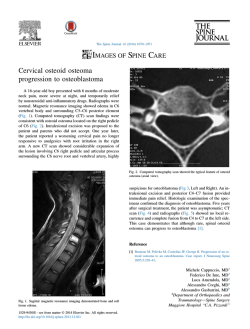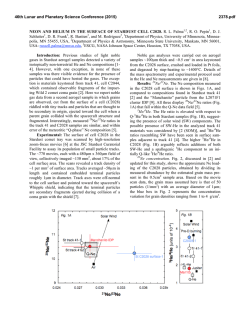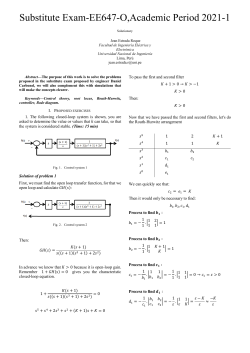
sol ExF EE647O 2021-1
Universidad Nacional de Ingeniería Facultad de Ingeniería Eléctrica y Electrónica “SOLUCIONARIO EXAMEN PARCIAL” Sistemas de Control I (EE-647O) (Ciclo académico 2021-1) Ccoicca Leiva Jhonathan José [email protected] Abstract- The document contains the solution for the final exam of Control I. Solution: a) I. I disagree with the L.G.R. shown: INTRODUCTION In this work we will appreciate the use of the concepts and methods provided in class for the analysis and resolution of exam final of control system I, where the following topics were presented: the geometric place of the roots, the Routh-Hurwitz stability criterion and bode diagrams. . II. PROBLEMS SOLVE A. Problem 1 A student in the Control Systems I course is asked to determine the L.G.R. of a certain open-loop system (GH(s)), which is represented by the following graph, and then it is asked: a) Do you agree with the L.G.R. shown?, If there is an error in its drawing, where would the error made by the student be when drawing the L.G.R.? Agree or not, how do you come to that conclusion? b) According to your previous answer, what would be the stroke of the L.G.R. with the poles (x) and zeros (o) already located in the diagram? c) With all the information obtained, what is the open-loop transfer function (GH(s)) represented in the L.G.R.? Fig. 2 Place where the error is found. We notice that the only possibility is that they are located in the figure 2.2 are two poles and in the direction shown one pole would be looking for another pole and that should not happen in the L.G.R. Fig. 1 L.G.R. b) The LGR will be: B. Problem 2 The following figure presents a block diagram of a specific control system. Fig. 5 Block diagram. So, you are asked what values can the open loop gain (K) take, so that the system is stable? Fig. 3 The corrected L.G.R. c) Solution: To find out if the system is stable we apply the Routh-Hurwitz criterion. The open-loop transfer function will be: ( ) ( ( )( ) )( )( ) Doing: Then, characteristic equation in closed loop: ( ) We will simulate the open-loop transfer function: ( ( ( )( ) ) ) ( ) ( ) We verify that all the coefficients of the equation meet the following condition: They have the same sign. 0…(1) Fig. 4 LGR graph obtained by simulation with Matlab live. ⇒ k’ ∈ ℝ+ ⇒ ’ > From some of the traces in the magnitude diagram (not all), you are asked to identify: Where: | a) What elements does the plant have and where are they located? b) What is the static gain of the plant? | Solution: a) Identifying the elements that the plant has in the Bode diagram: | | | ( ⇒ | ) Fig. 7. Bode diagram with the identified elements. We notice that all the terms in the first column of Routh's table are positive, so the system is stable. In (1): Then, the open-loop transfer function would be: ( ) ⇒ C. Problem 3 For the frequency response shown below, it belongs to a negative and unit feedback plant. ( ( )( ) )( ) Finding k: …( ) Then: ( ( )( ) )( …( ) ) (1)= (2): ( ) ( ( )( ) )( ) b) ( ) ( )( )( ) REFERENCES Fig. 6. Bode Diagram [1] K. Ogata, Ingeniería de control moderna, 5th ed, Madrid 2010, pp. 29-164. [2] C.Chen, Analog and digital control system design, 3rd ed., New York: McGraw-Hill Book Company, 1993, pp.116. [3] Dorf, R. C., and R. H. Bishop, Modern Control Systems, 9th ed. Upper Saddle River, NJ: Prentice Hall,2001., pp. 209-223.
© Copyright 2025










